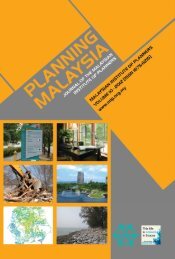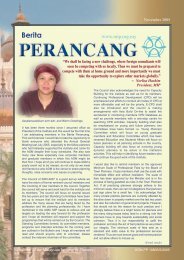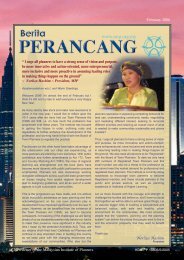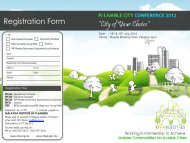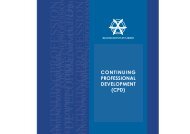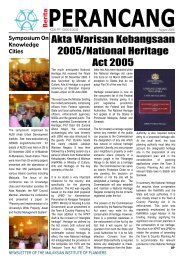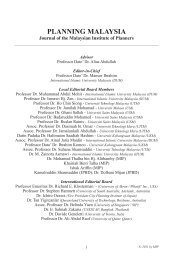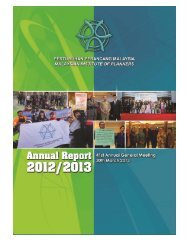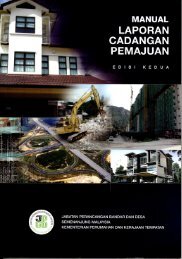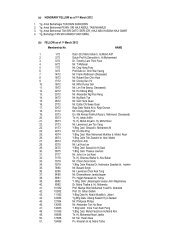mip patron tun dr mahathir mohamad honoured - Malaysian Institute ...
mip patron tun dr mahathir mohamad honoured - Malaysian Institute ...
mip patron tun dr mahathir mohamad honoured - Malaysian Institute ...
Create successful ePaper yourself
Turn your PDF publications into a flip-book with our unique Google optimized e-Paper software.
litres per capita per day in 2011. Per capita consumption in<br />
the west coast states in Peninsular Malaysia are all above the<br />
national average.Some industry experts argued that the real<br />
figures are much higher, closer to 300 litres per person per day.<br />
But our daily per capita usage is indeed higher than Singapore<br />
(155 litres), the Philippines (175 litres) and Indonesia (130 litres).<br />
If we compare with more advanced countries, in Denmark it is<br />
only 114 litres, Australia 150 litres, England & Wales 150 litres.<br />
USA is perhaps the only country that consumed more than us, at<br />
300-380 litres per capita per day!<br />
Some Third World countries don’t even have half the water we<br />
used daily. The UN Population Fund recommended that the fair<br />
level of domestic water usage is 100 litres per person per day.<br />
We can get by with just 30 litres for <strong>dr</strong>inking and cooking and to<br />
maintain hygiene.<br />
We also suffer huge losses due to non-revenue water (NRW),<br />
largely due to leaking pipes that transport water to our taps and<br />
water theft. NRW for Kelantan, Pahang, Perlis and Sabah is more<br />
than 50%.The highly industrialised and developed states in the<br />
country are already experiencing pressures from acute supplies<br />
to meet the demands from their residents, the industries and<br />
the development projects. The loss from NRW is estimated at<br />
about 43% of total water revenue! And if we look at it in another<br />
simple minded way, it would also mean that for whatever amount<br />
we invested in creating new water supply (such as building more<br />
dams and treatment plants) we are only going to get half the<br />
value invested before we even start the construction if we don’t<br />
tackle the NRW first.<br />
Leaking pipe<br />
Not many people realised that we flushed 30% of our water<br />
down the toilets and spent another 35% in the showers or baths.<br />
Only 10% is actually used for <strong>dr</strong>inking and cooking. Laun<strong>dr</strong>y and<br />
cleaning takes the other 25%.It doesn’t make sense for us to<br />
spend so much money to supply treated water and then 90% of it<br />
just went down the <strong>dr</strong>ains and sewers.That’s after we have lost<br />
nearly half of it through leaky pipes (NRW). Silly, aren’t we?Our<br />
water supply is so heavily subsidised and the water from our tap<br />
is so cheap that we are not bothered by our wasteful habits.<br />
Only when we turn our taps on and no water came out will we<br />
start jumping and tearing our hair out.<br />
Try telling an African in Ethiopia that we used clean water to<br />
flush the toilets and they will probably think that we are crazy.<br />
One third of the world population is already facing problems<br />
of water shortage and poor quality <strong>dr</strong>inking water. UNESCO has<br />
predicted that water shortage will be a worldwide problem by<br />
2020. Prophets of doom have wagered that the next world war<br />
will be over control of fresh water supplies, not oil. We can live<br />
fairly comfortably without electricity for a day or two (although<br />
a lot of people will have suffered Internet with<strong>dr</strong>awals!), but<br />
not without water!<br />
Although 70% of the human body is water, we cannot survive<br />
more than a week without water. Water is life. Without water<br />
there is no life. In the Quran it is stated, “Behold! in the creation<br />
of the heavens and the earth; ... in the rain which Allah Sends<br />
down from the skies, and the life which He gives therewith to<br />
an earth that is dead;...” (2:164); “And Allah has created every<br />
animal from water...”(24:45); “... It is He Who has created man<br />
from water...(25:54)” (translations by Abdullah Yusuf Ali).<br />
Singapore has put in place their long term strategy for their water<br />
supply. They will not be highly dependent on water supplied<br />
from Johor anymore come 2060. The second of the two bilateral<br />
agreements with Johor will expire in 2061.The first agreement<br />
expired in 2011. They have put in place measures to ensure selfsufficiency<br />
by recycling their wastewater for consumption that<br />
they termed NEWater.<br />
NEWater will supply40% of Singapore’s water needs by 2020 and<br />
a further 25% supplied by desalinisation. NEWater is primarily<br />
for non-potable industrial uses. A small percentage of NEWater<br />
is also blended with raw water in the reservoir for treatment<br />
as potable water. They will cut their per capita consumption<br />
to 147 litres per day. By 2060, NEWater will supply 50% and<br />
desalinisation another 30% of their water supply.This is sensible<br />
considering that only 30% of demand comes from Singapore’s<br />
domestic sector and the non-domestic sector consumes the<br />
other 70%. Furthermore, we are going to literally flush 90%<br />
of the water down the <strong>dr</strong>ains anyway. It is a win-win situation<br />
because recycling most of our wastewater also means that we<br />
reduce the possibility of polluting our waterways.<br />
In our case, we are not only consuming too much but we are<br />
also polluting our water sources. And our strategy in the past<br />
has always been to build more dams. The first National Water<br />
Resources Study commissioned in 2000proposed the construction<br />
of another 50 dams to meet our water demand by 2050! This was<br />
based on a continuous linear growth of demand. That’s a big<br />
assumption that our rivers will be able to supply enough water<br />
way beyond 2050 and we cannot change our water consumption<br />
habits.<br />
There have been very little discussions about managing demand<br />
and cutting down our daily per capita usage. Our focus has been<br />
too much on the supply (and the potential profits that can be<br />
made from construction of water supply facilities!).Demand<br />
management is a very important strategy that complements<br />
the supply strategy, because water supply in not infinite. We<br />
should not wait until our potential water resources have been<br />
exhausted before we start looking at managing the way we use<br />
water.<br />
There have not been enough efforts towards cleaning up our<br />
rivers that passes through our urban centres to return them to<br />
at least Class IIB level (i.e. suitable for recreational use with<br />
body contact) so that we can use them again for recreation. For<br />
several decades more than 50% of our urban rivers monitored<br />
by Jabatan Alam Sekitar have lingered within the polluted and<br />
slightly polluted range. The main contributors to river pollution<br />
have been named as sewage treatment plants (I thought they<br />
were supposed to clean the wastewater?), manufacturing<br />
industries and palm oil mills. Earthworks have also been a major<br />
contributor of pollution of our rivers.<br />
We have the technologies now to clean wastewater up to<br />
standard A (as clean as the pristine river water) of effluent<br />
discharge. Hence, water discharged from our sewage treatment<br />
plant that utilises this technology will be cleaner than water<br />
from our rivers. Taking water from the river now is akin to taking<br />
water from the sewer since we treat our rivers like one! In my<br />
course of work I have come across a river where the water<br />
sampled is almost Class IV (suitable only for irrigation, not even<br />
suitable for livestock consumption!) near a water intake point!<br />
Let’s not wait until the last tree has been cut, the last fish has<br />
been caught and the last river has been poisoned before we<br />
realise that money cannot be eaten!<br />
Note: this article was originally written and published in Berita MCOBA.<br />
It is reproduced here with permission.<br />
NEWSLETTER OF THE MALAYSIAN INSTITUTE OF PLANNERS 9



